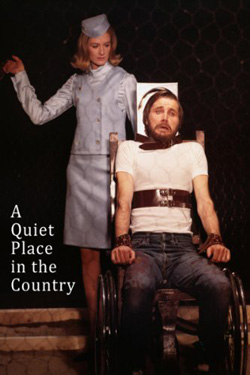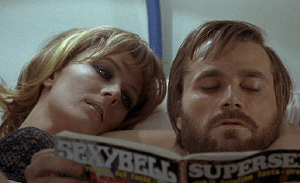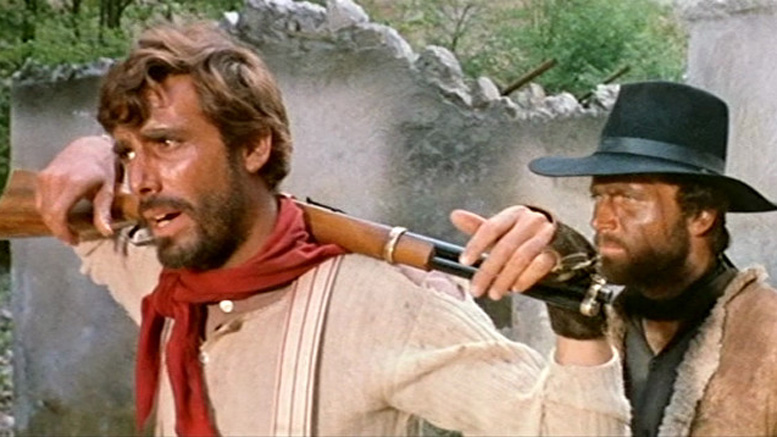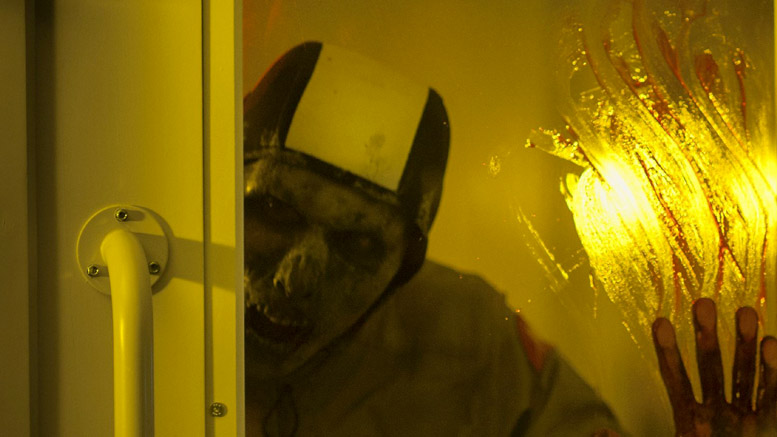
Aka Un coin tranquille à la campagne (Fr), Un tranquillo posto di campagna (It)
Italy / France
1968
An Alberto Grimaldi production for Produzioni Europee Associate (Rome) & Les Productions Artistes Associés (Paris)
Director: Elio Petri
Story: Tonino Guerra, Elio Petri
Screenplay: Luciano Vincenzoni, E. Petri
Cinematography: Luigi Kuveiller {Technicolor – Panoramico}
Music: Ennio Morricone, with songs sung by Edda Dell’Orso
Editor: Ruggero Mastroianni
Art director: Sergio Canevari
Cameraman: Ubaldo Terzano
Release dates & running times: Italy (14/11/68), France (14/08/69, 105 mins), UK (71, 106 mins)
Filmed: Cinecittà Studios (Rome)
Italian takings: 387.000.000 lire
Cast: Franco Nero (Leonardo Ferri), Vanessa Redgrave (Flavia), Georges Geret (Attilio), Gabriella Grimaldi (Wanda), Madeleine Damien (Wanda’s mother), Rita Calderoni (Egle), Renato Menegatto (Egle’s friend), David Mansell (the medium), John Francis Lane (the asylum nurse), Valerio Ruggeri, Arnaldo Momo (a villager), Constantino De Luca (a villager), Marino Biagiola (a villager), Piero De Franceschi (a villager), Camillo Besenzon (a villager), Renato Lupi, Umberto Di Grazia, Giuseppe Bello, Bruno Simionato, Graziella Simionato, Giulia Menin (a villager), Snoopy the dog
IMDB credits: Mario Simionato (a villager), Elena Vicini, Onofrio Fulli, Otello Cazzola (a villager), Sara Momo (a villager)
Ostensibly a ghost story, the following year’s A Quiet Place in the Country is, in fact, an atmospheric rumination upon the nature of art, pornography, insanity and – heck – life itself. Adapted from a 1911 story by Oliver Onions (‘The Beckoning Fair One’), Tonino Guerra and Elio Petri’s script was unused for five years before being dusted off and revised by Petri and the talented Luciano Vincenzoni (Death Rides a Horse (Da uomo a uomo, 68)).
The story concerns Leonardo Ferri (Franco Nero), a modernist painter whose work is composed of formless colors arranged on huge canvasses. He lives with his agent, Flavia (Vanessa Redgrave), who organizes his life in every way: arranging meetings with clients, paying him a daily allowance, even wiping his beard clean in public. Sick of living in the city – which he finds full of distractions (i.e. women) – he decides to move to the country.
He soon becomes obsessed with a huge, decrepit villa on the outskirts of Venice and, despite Flavia’s concerns, moves in. Strange things begin to happen: doors open and close of their own accord, an unseen force throws around paint and a pair of scissors mysteriously appears from nowhere. More alarmingly, Leonardo’s already odd dreams become increasingly disturbing, beginning to seep into his waking hours.
It becomes apparent that a young woman, Wanda (Gabriella Grimaldi), had been killed in the villa during a Second World War air raid. Leonardo is convinced that her ghost is responsible for the disquieting events, and starts digging into her past: extremely beautiful, she had a reputation as a nymphomaniac and had slept with most of the men in the town. As he discovers more about her bizarre past, he becomes convinced that her death was not exactly as it seems. He is repeatedly drawn toward certain objects and forms: the color red, a stack of photographs of the dead girl, some bullet-holes in the wall.
A Quiet Place in the Country is an incredibly uncomfortable film to watch. Petri’s work often has an overwrought edge, but here the hysterical atmosphere is all pervading. There is a purpose for this, as it reflects the increasing dementia of the lead character, but it really doesn’t make the viewing experience any easier. The confrontational nature of the film is apparent within the opening five minutes. After the credits roll – accompanied by atonal jazz music and with ‘mock’ scratches on the filmstock – we are treated to a sequence in which Leonardo is tied to a chair whilst Flavia harasses him with assorted electrical devices, before stabbing him to death in the shower. Unsettling in itself, this is also demonstrates possibly the most unsafe use of a multiplug adaptor ever committed to celluloid. It may all be a dream, but it certainly manages to kick things off in a sinister fashion.

The general edginess is accentuated by the discordant Morricone music, occasional outbreaks of violence and some taut direction, which makes much use of jittery editing, whispered voiceovers and disconcerting flashbacks (or flash-forwards). There is a very odd looking supporting cast, and Franco Nero contributes an aggressively manic, brutal performance; it is hard to believe that it is the same guy who was such a minimalist actor in Django (66). This was one of a number of bizarre euro-productions to star Nero and Redgrave at around the same time: Dropout (71) and La vacanza (69) were both directed by Tinto Brass, have fallen into complete obscurity and sound similarly challenging.
Many of Petri’s recurrent themes are present and correct, both stylistic and narrative. There is Flavia’s obsession with consumer goods (‘an underwater television for scuba diving, an erotic electro magnet, a tiny automobile to go round from room to room’), which is contrasted with the artist’s spartan existence in the villa. Surrealism bubbles beneath the surface – Leonardo paints some trees bright red on a whim and suffers from troubling hallucinations – and, if you look deep, there’s a wicked sense of outre humor at play (‘you can’t kill me with that, it’s just a giant paperclip’)
Something new for the director is the fascination with pornography (this would again surface in his last film, Good News). Leonardo is obsessed with girlie magazines – he reads them in bed with Flavia – and views slides of distorted, naked bodies whilst working. His sight is continually drawn towards female breasts, as he ogles and gropes his way through all the women in his vicinity. In fact, despite seeming to be something that he has command of, porn is used to control him; as is made explicit with the cynical ending, which finds him confined in a mental institution, painting tiny pictures in exchange for copies of playboy.

